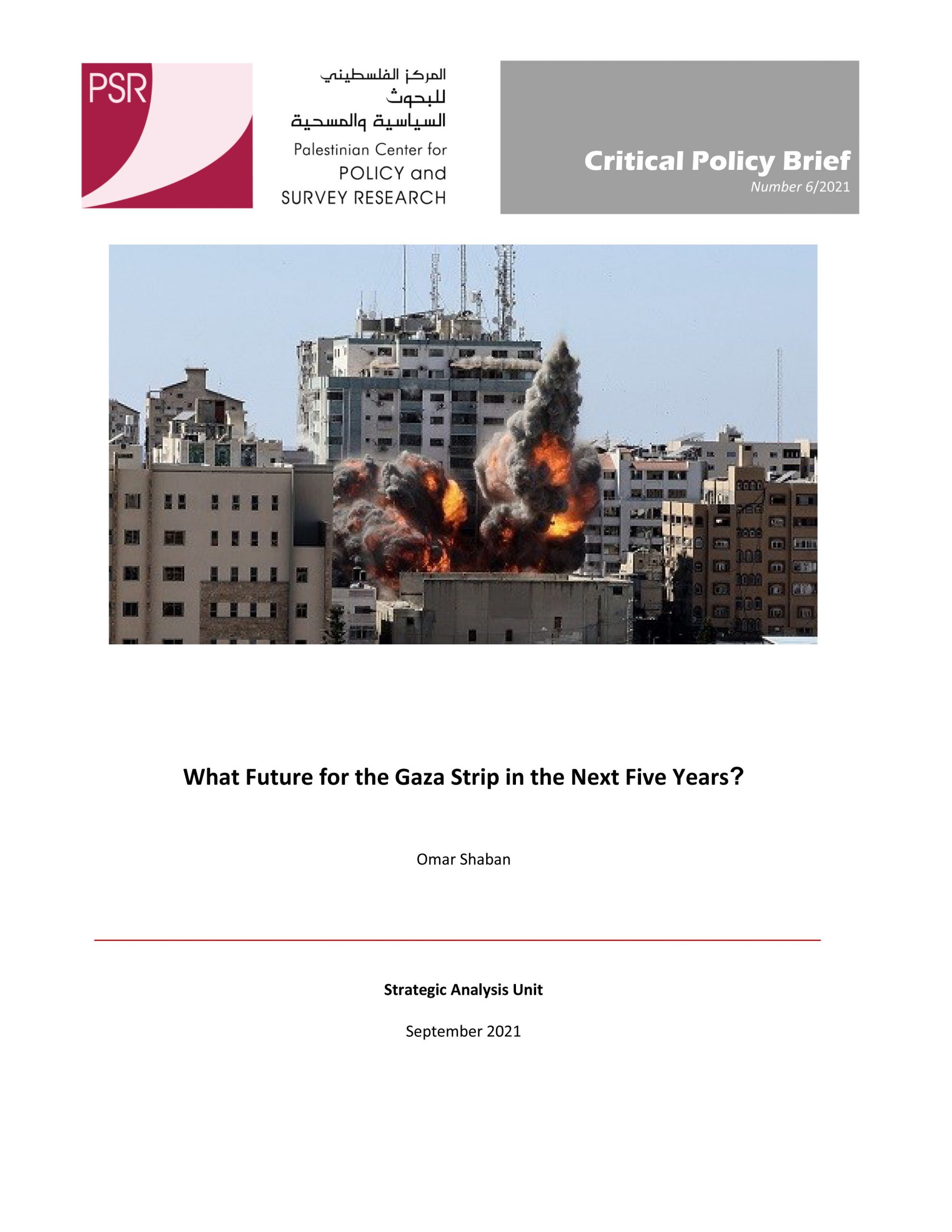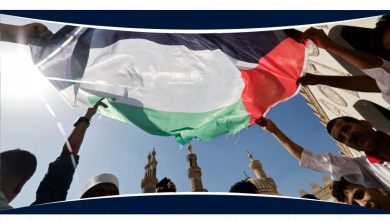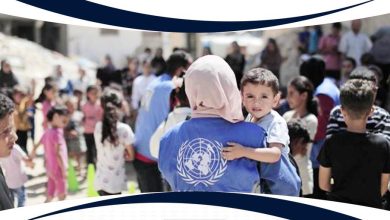What Future for the Gaza Strip in the Next Five Years?
Omar Shaban
 Since the Palestinian division occurred in June 2007, the Gaza Strip has become a geographical area with a political and legal context different from the West Bank. The Gaza Strip is a small area in size, but a large one in problems. It is under the rule of Hamas, which is not recognized in the Arab world, nor internationally. After Hamas took control of the Strip, Israel imposed a comprehensive blockade and exposed it to four, long, destructive wars and dozens of smaller armed confrontations over 14 years. The policy of the suffocating blockade enforced by Israel, as well as the repeated wars and military attacks, have created an unprecedented humanitarian crisis and resulted in massive destruction of infrastructure and all economic sectors and activities.[1] The Gaza Strip is supposedly part of the territory of the Palestinian Authority (PA) and the future state, according to international resolutions and the Oslo Agreement signed between the PLO and Israel. However, as it is not geographically connected to the remaining Palestinian territory, and, since the Palestinian division in 2007 that brought it outside the control of the PA, and the failure of attempts at reconciliation and unity, the question is again raised: ‘What is the future of the Gaza Strip within the next five years?’
Since the Palestinian division occurred in June 2007, the Gaza Strip has become a geographical area with a political and legal context different from the West Bank. The Gaza Strip is a small area in size, but a large one in problems. It is under the rule of Hamas, which is not recognized in the Arab world, nor internationally. After Hamas took control of the Strip, Israel imposed a comprehensive blockade and exposed it to four, long, destructive wars and dozens of smaller armed confrontations over 14 years. The policy of the suffocating blockade enforced by Israel, as well as the repeated wars and military attacks, have created an unprecedented humanitarian crisis and resulted in massive destruction of infrastructure and all economic sectors and activities.[1] The Gaza Strip is supposedly part of the territory of the Palestinian Authority (PA) and the future state, according to international resolutions and the Oslo Agreement signed between the PLO and Israel. However, as it is not geographically connected to the remaining Palestinian territory, and, since the Palestinian division in 2007 that brought it outside the control of the PA, and the failure of attempts at reconciliation and unity, the question is again raised: ‘What is the future of the Gaza Strip within the next five years?’
Four assumptions:
The following discussion takes for granted the continuation of four aspects of the current status quo:
Continued Palestinian division, continued Hamas control of the Gaza Strip: Numerous attempts have failed to achieve reconciliation and reinstate the PA as the ruler of the Gaza Strip. The last attempt was the formation of the reconciliation government in June 2014, as a result of the Shati agreement of April 2014. After a break of several years, rounds of dialogue were renewed between representatives of Hamas and Fatah, hosted in the capitals Istanbul, Cairo and Doha in September 2020.[2] However, they did not succeed in achieving reconciliation. The failure of the reconciliation rounds means that Hamas will remain in power in the Gaza Strip. Israel does not conceal its efforts to prevent national reconciliation and stop the return of the PA rule over the Gaza Strip.
The Israeli-Palestinian conflict remains unresolved: The optimism that prevailed in Palestinian and international circles with President Joe Biden’s coming to power in the United States soon faded, as the new US administration did not initiate any move to resume the track of negotiations between the Palestinian Authority and Israel. The first communication between presidents Biden and Mahmoud Abbas took place because of the war between Israel and the factions in Gaza in May 2012. The US intervention, which came somewhat late, was prompted by the war on Gaza but was limited to economic interventions and financial assistance while removed from any political path. Further, the first meeting between President Abbas and the Israeli government, the meeting with defense minister Benny Gantz in August 2021, dealt only with security and economic and humanitarian issues and aimed at strengthening the Authority, enhancing security coordination and preventing collapse. Israeli media quoted Prime Minister Naftali Bennett’s statements, stressing that ‘there is no political process with the Palestinians, and there will not be such a process.[3] ’There is no political path in the foreseeable future.
Ongoing blockade and closure: With the end of the May 2021round of confrontations between Israel and the Gaza Strip, the new Israeli government announced its clear position of continuing the blockade of the Strip, preventing the reconstruction process, and linking any easing of hardships to the issue of the Israeli prisoners, ostensibly held in Gaza.[4] This Israeli intransigence saw some flexibility with regard to the blockade, where pressure from mediators forced the new Israeli government to allow some relief to avert a new war, including transferring part of the Qatari grant funds, allowing the entry of raw materials, including building materials, the expansion of the fishing zone, and allowing thousands of Gazan workers to enter Israel. However, these facilities do not amount to the lifting the total blockade imposed on the Gaza Strip.[5]
Current regional environment remains unchanged: It is expected that the regional environment will remain relatively stable, without a meaningful or qualitative change. The main relevant regional players are Egypt, Iran, Jordan, Turkey and Qatar. These countries, which represent the various interests in the region, are not united in their position on Hamas and the Gaza Strip. At a time when Iran, Turkey and Qatar’s relations are open with Hamas, providing humanitarian aid and some political recognition, the relationship of Egypt and Jordan with Hamas is witnessing much fluctuation, governed by a de facto reality and no more. Disputes among the countries of the region are clearly reflected in their relations with Hamas. These countries are preoccupied with their internal issues and have no intention of bringing about a qualitative change in their relations and positions on Hamas, in particular, and the Gaza Strip, in general.
Anticipating the future of the Gaza Strip in the next five years
In light of these assumptions, this paper examines the available and possible options for the Gaza Strip in the next five years. It is based on a reading of the positions of the relevant parties and the degree of their interaction with the internal environment, as well as the ongoing discussion within Hamas on alternatives paths to take to get out of the crisis that has persisted for 14 years. In an attempt to anticipate the future of the Gaza Strip in the next five years, three alternatives to the status quo can be identified: a the return of the Gaza Strip to PA control, a Hamas-Israel long term truce, and an independent Gaza entity.
First option: achieving reconciliation, returning the PA to rule, with the participation of Hamas
This scenario assumes the realization of full national reconciliation. Since the division, attempts have not ceased in order to achieve this. Yet, despite many reconciliation agreements (Aden 2008, Cairo 2011, Doha 2012, Al-Shati 2014, and Cairo 2017), the outcome has been failure. The presidential decree that came in January 2021[6] to hold legislative and presidential elections in May and July 2021 restored hope for national reconciliation. But this hope was soon dashed by the president’s decision to postpone the elections, under the pretext of Israel’s refusal to hold them in Jerusalem. This was preceded by a series of attempts towards national reconciliation between Hamas and Fatah, the most recent of which was on September 24, 2020 in Istanbul, resulting in a shared vision towards the resolution of the outstanding issues between the two parties, such as reforming the PLO, the appropriate means of resisting occupation, and the use of popular resistance.[7] With the postponement of the elections and the war on Gaza in May 2021 (which contributed to a significant increase in the popularity of Hamas and was accompanied by a severe deterioration in the position of the Palestinian Authority), and given the assassination of activist Nizar Banat, the vaccine deal with Israel, perceived by the public as the result of corruption within the PA, and other issues, the gap between the two movements widened, making reconciliation more elusive than before. An opinion poll conducted by the Palestinian Center for Policy and Survey Research shows that the popularity of the Palestinian president dropped dramatically after the Israeli aggression on the Gaza Strip in May 2021, falling, in a contest between Abbas and Hamas’ Ismail Haniyyeh, from 47% in March 2021 to 27% in June 2021. Further, the poll indicates that 53% view Hamas as the worthiest of representing and leading the Palestinian people, compared with only 14% in favor of the Fatah movement led by President Abbas.[8]
After the tripartite meeting in Cairo between the Palestinian and Egyptian presidents and the Jordanian king, in September 2021, President Mahmoud Abbas highlighted “the need” for Hamas to recognize international legitimacy, and added that “if it recognizes that legitimacy, we can immediately form a national unity government.”[9] This is a position previously rejected by Hamas and some Palestinian factions.
Within Hamas, there is no consensus among its leaders on the terms for reconciliation with the Palestinian Authority and the Fatah movement. Inconsistent statements have been made by Hamas leaders on the extent of concessions that must be made. This is also the case within the Fatah movement and some of its allied factions. Positions of the two sides reflect different convictions on who should emerge as the predominant Palestinian player. Additionally, several thorny issues prevent reconciliation, including Hamas’ insistence on retaining its weapons and military and security apparatus, contrary to the desire of President Mahmoud Abbas, who demand one-weapon and one-law and rejects the model of Lebanon’s Hezbollah in Gaza. There is another difficulty represented in the administrative and security integration of employees working with the Hamas government, financial collection, the judiciary, land, and the lifting of sanctions.
Moreover, there is a belief within the Hamas movement that time works to its advantage, as it accumulates more experience and support in the region, as happened with the May 2021 war. Hamas believes that the prospects for reconciliation will be better in the absence of the Palestinian president. In the meanwhile, this view is bolstered by sustained deterioration in the popularity of its rival, Abbas and Fatah, and the potential outbreak of an internal conflict on succession, both within Fatah and the PA. In other words, Hamas is not in a hurry for reconciliation.
Second option: reaching a long-term truce with Israel
Since Hamas assumed control over the Gaza Strip in 2007, its relations with Israel have been tense, occasionally oscillating between various priorities. The need to meet the needs of the population under its control and to assert its control came in conflict at times, with its desire to preserve its position as a leader of armed struggle against Israel. Following armed confrontations, concerns about rebuilding the Strip’s destroyed infrastructure constituted another priority. Hamas has signed several truce agreements with Israel after these wars (2009, 2012 and 2014), but they were of short duration. Hamas is conducting a semi-continuous dialogue with Israel, with Egyptian, Qatari and UN mediation, to obtain a number of economic and material improvements as well as opening of the crossings, issuance of permits to workers, and others. On the onset of each conflict, Israel withdraws these facilities and then renegotiates them.
In the meanwhile, Hamas confirms, now and then, that it does not want more extensive military clashes with Israel, but is seeking to stop the escalation, on condition of easing the blockade, yet without abandoning the principle of armed struggle against Israel. Hamas sees its rule of the Gaza Strip and continued discourse of resistance and struggle against occupation as necessary elements in the formulation of its identity that ensures continued support for it, as well as gaining the attention of third parties, both allies (Qatar, Turkey and Iran) and opponents (Israel, Egypt, the Palestinian Authority). Hamas bears the burden of governance and realizes that it needs some kind of relationship with the occupation, which is the main regulator of the Gaza Strip.
Hamas cannot go so far as to recognize Israel and sign a peace agreement with it. This position is driven by ideological reasons and its awareness that such a recognition would deprive it of its status as a resistance movement, and might cause it to lose popular support. Thus, it prefers to talk about a long-term truce. This position enables Hamas to retain its identity as a ‘resistance’ movement, and, at the same time, obtain important economic gains that enhance its ability to rule the Gaza Strip; in other words, combining resistance and governance. This Hamas’ equation is premised on obtaining humanitarian facilities and improvements, bypassing the blockade, and opening up the Gaza Strip to the outside world, in return for Israel enjoying calm on the borders for a long period of time. In the meanwhile, the Hamas movement oscillates between its past as a resistance movement, from which it departed, in part, in June 2007, and its present as a government tasked with caring for 2 million Palestinians. As things stand today, Hamas is at an intermediate stage between an armed organization and a government. Given this context, a long term truce with Israel fits Hamas’ intermediate goals.
Third option: an independent Gaza entity
In this alternative, the Gaza Strip becomes a small political entity on its own, one that enjoys sovereignty. In a wider context, this alternative maintains the current split as the Gaza Strip and the West Bank remain two territories that enjoy different levels of control or sovereignty. On de facto basis, the West Bank remains a region of cantons, becoming smaller with time, while enjoying administrative autonomy. It would remain nominally linked to Gaza, in which the rule would be more broadly independent. This scenario gains traction due to the long, ongoing Palestinian division, without prospects for reconciliation as the rift between Hamas and Fatah deepens.
After the long years of division, a feeling has grown among some segments of Palestinian society that it is impossible to achieve reconciliation and that the Gaza Strip must seriously consider finding exits from the humanitarian crisis. The division has also caused other societal, political and economic transformations, which, in turn, have contributed to deepening the separation between Gaza and the West Bank. This alternative finds support in Israeli national security circles that view positively the separation between the West Bank and Gaza. It has been articulated by General Giora Eiland, the architect of the notion of expanding the Gaza Strip. He has called on the Israeli governments to come out of its traditional caution and reach a comprehensive deal with the Gaza Strip, including an exchange of prisoners. This would lead to the de facto creation of a Gaza emirate or statelet and the transformation of Gaza into the center of a Palestinian state, with the cantons in the West Bank serving as satellites to it.[10]
The PA leadership, the Fatah movement, and many opinion writers have accused Hamas of seeking to establish an independent entity in the Gaza Strip.[11] This accusation found evidence in the fertile ground in provided by procedures adopted and decisions taken by Hamas since it took the reins of power in the Gaza Strip. These included the formation of an administrative commission for de facto rule of Gaza; the shuttle visits by many Hamas leaders to some countries as representatives of the Palestinian people; and the presentation of its political document in May 2017, the Hamas’ modified platform, by which it aimed at marketing itself as a political movement more flexible and adaptable to the requirements of the international community.[12]
In many occasions, Hamas, the movement and the government, stated that the Gaza Strip contributes to the budget of the Palestinian Authority and that the Gaza Strip can thrive if it obtains its own clearing funds. Hamas understands that the Gaza Strip has natural resources, such as gas, overlooks the Mediterranean Sea, and has a reasonable wealth of fish, all of which are resources that encourage the thinking that the Strip can rely on its own. Hamas has in many occasions rejected the idea of an independent Gaza entity and has always affirmed its declared position that there is “no state in Gaza and no state without Gaza.” But President Abbas stated to the Egyptian magazine Rose al-Yousef that Hamas conducts “security coordination with the occupation” and has conducted negotiations with Israel during the term of ousted Egyptian President Mohamed Morsi in order to establish a state in Gaza. Mousa Abu Marzouk, of Hamas, replied: ‘Mr. President, Hamas wants a state not only in Gaza, but in all of Palestine, and you cannot shirk your responsibilities towards besieged Gaza with these excuses.’[13]
Positions of the relevant states
Positions differ among the relevant states and stakeholders that have an impact on the situation in the Gaza Strip. The declared Israeli position is in maintaining the Palestinian division, sparing Israel from starting on a negotiation path with the Palestinians. Meanwhile, the Palestinian Authority’s consistent position is to prevent the separation of the Gaza Strip and keep it under its control in order to strengthen its negotiating cards with Israel, the United States and the region. Egypt and Jordan, which take an ideological stance hostile to Hamas, agree with this position. Both countries employ a de facto policy in engaging with the Hamas movement as the force present on the ground, but without allowing it to become an entity recognized internationally. They do not, at all, want to be neighbors to an independent entity governed by a movement that is part of the Muslim Brotherhood. In reviewing the three scenarios, the stark difference in the positions of these countries towards the future of the Gaza Strip becomes apparent. Israel prefers the option of stalling, or maintaining the status quo, until conditions ripen to allow the option of disengagement along a long term truce to mature. The proposal of Israeli Foreign Minister Yair Lapid, which he presented at the Herzliya conference this week, can be included in this scenario, which is in line with the Israeli strategic position based on maintaining the Palestinian division and limiting the capabilities of Hamas and other armed factions, while providing attractive facilities to Hamas.
Conclusion
It is clear, from the review of the alternatives above, that the future of the Gaza Strip is difficult to design without Hamas being a key actor. It goes without saying that Israel, the principal decision maker regarding the Gaza Strip, is not interested in signing a peace agreement with Hamas. But Israel is inclined to pursue the option of a long-term truce, lasting perhaps for 15 to 20 years. This option is in line with its strategic interest to preserve the Palestinian division and prevent the return of the Palestinian Authority to Gaza. Furthermore, maintaining a state of hostility is in the interest of both parties, Israel and Hamas. Each uses this hostility to justify its policies. Thus, Israel, on the one hand, attacks the Gaza Strip from time to time and pursue an ongoing policy of assassinations and detentions while on the other hand conducts indirect negotiations with Hamas in order to curb its power and assign its jurisdiction to ‘internal police’. This is a balanced equation, with carefully thought-out outputs that support the scenario of stalling. Immediately after the last round of war between Israel and the Gaza Strip, which lasted for 11 days, the coalition government, led by Naftali Bennett, resumed its hints at “security in exchange for calm” with limited economic improvements, in the context of emphasizing the continuation of the division and preventing the collapse of the rule of Hamas. Successive Israel governments have succeeded in convincing the Israeli public that the continued separation between the West Bank and Gaza is in Israel’s interest and is the most appropriate solution for it. Israel also realizes the need and desire of Hamas to continue ruling Gaza.
While the ideal option for Palestinians is to achieve reconciliation between Ramallah and Gaza, which would preserve the two-state solution, the most likely scenario in the next five years is the continuation of the status quo, with no viable alternative. It is the scenario that does not anger the PA and will not find serious objection from Egypt and Jordan; it is the option that has become familiar to the region.
[1] covid-19 crisis, https://bit.ly/3lDxior
[2]Al-Quds Al-Arabi: Expected rounds and contacts between Fatah and Hamas to discuss entering the elections with a joint list https://bit.ly/3CtddrY
[3]Al Jazeera.net: After Abbas and Gantz meeting, Bennett denies the existence of a political process with the Palestinians, Hamas and Islamic Jihad condemn https://bit.ly/3CtAycH
[4]RT Arabic: A dispute over Israeli prisoners held by ‘Hamas’ hinders the reconstruction of Gaza https://bit.ly/2ZfXXjT
[5]Madar: Naftali Bennett’s strategy and options regarding the Gaza Strip… Is there a radical change? https://bit.ly/3lHvOcX
[6]WAFA: The President issues a presidential decree setting the date for holding general elections in three stages https://bit.ly/3kmd6bd
[7]Anadolu: ‘Fatah’ and ‘Hamas’ conclude ‘Turkey’ talks in agreement on a ‘vision of dialogue’ https://bit.ly/2XsOYLh
[8] Palestinian Center for Policy and Survey Research, Results of Public Opinion Poll No. (80)https://bit.ly/39ky7wQ
[9]Rose al-Yousef magazine: Palestinian President Mahmoud Abbas in an interview with ‘Rose al-Yousef’: Peace initiatives are ‘dead’, and there is no alternative to reconsidering all agreements with Israel https://bit.ly/3zmPvvo
[10] Press Briefing by Maj. Gen. Giora Eiland – Head of the IDF Operation Branch – on the Tenet cease-fire agreement-14-Jun-2001, https://bit.ly/3Cn7Fz5
[11]Sama al-Akhbariya: The making of the State of Gaza, D. Ibrahim Abrash, https://bit.ly/2Z5ZxVb
[12] A Document of General Principles and Policies (Hamas Movement), https://bit.ly/3zkHpDl
[13]Palestine Today: Abu Marzouk: Hamas wants a state in all of Palestine, not just in Gaza. https://bit.ly/2Xut3TG




